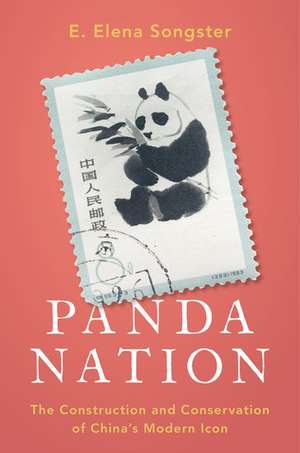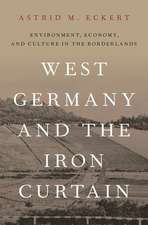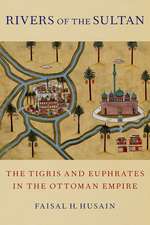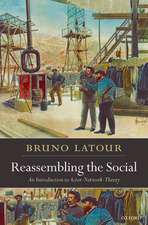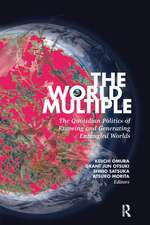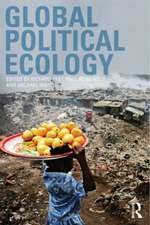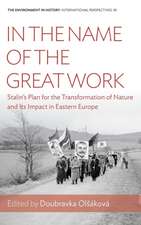Panda Nation: The Construction and Conservation of China's Modern Icon
Autor E. Elena Songsteren Limba Engleză Hardback – 17 mai 2018
| Toate formatele și edițiile | Preț | Express |
|---|---|---|
| Paperback (1) | 159.99 lei 11-16 zile | |
| Oxford University Press – 17 iul 2020 | 159.99 lei 11-16 zile | |
| Hardback (1) | 395.06 lei 32-37 zile | |
| Oxford University Press – 17 mai 2018 | 395.06 lei 32-37 zile |
Preț: 395.06 lei
Preț vechi: 519.20 lei
-24% Nou
Puncte Express: 593
Preț estimativ în valută:
75.59€ • 78.77$ • 62.59£
75.59€ • 78.77$ • 62.59£
Carte tipărită la comandă
Livrare economică 24-29 martie
Preluare comenzi: 021 569.72.76
Specificații
ISBN-13: 9780199393671
ISBN-10: 0199393672
Pagini: 264
Ilustrații: 27 hts
Dimensiuni: 236 x 157 x 28 mm
Greutate: 0.5 kg
Editura: Oxford University Press
Colecția OUP USA
Locul publicării:New York, United States
ISBN-10: 0199393672
Pagini: 264
Ilustrații: 27 hts
Dimensiuni: 236 x 157 x 28 mm
Greutate: 0.5 kg
Editura: Oxford University Press
Colecția OUP USA
Locul publicării:New York, United States
Recenzii
Songster's book provides a concise, intriguing, and convincing narrative for both scholarly and public readers interested in the political, cultural, scientific, and environmental history of giant pandas. It is also a valuable contribution to Chinese conservation and environmental history, illuminating the complex interactions of science, nature, and the nation in the PRC.
Songster's much anticipated book Panda Nation: The Construction and Conservation of China's Modern Icon admirably fills a gap in the historiography of China's environment by tracing the giant panda's post-1949 emergence as a Chinese national icon and a global symbol of wildlife conservation...Songster's book...will reward anyone, from undergraduates to senior scholars, with an interest in how the panda gained its iconic status, and how that story relates to modern Chinese history more generally.
By choosing instead to tell the multi-faceted story of how humans constructed and conserved this particular species, Songster is able to speak to a much wider audience interested in China's political, social, cultural and environmental history. To all of them, and in fact to readers looking for an unusual entry into modern Chinese history per se, Panda Nation can be highly recommended.
How did the giant panda, a shy creature rarely seen in the wild, not hunted for meat, and all but missing from historical texts, come to serve as a political tool for China's national pride, international diplomacy, and soft power projection? In answering this question, Songster draws on cultural history, archives, field research in Pingwu, news articles, scientific monographs, and interviews with some of the pioneers of giant panda biology and conservation.
Even those immune to the supposed charms of this charismatic megafauna must acknowledge the panda's place at the pinnacle of both Chinese national symbolism and international relief efforts. Songster's accessible and well-organized account historicizes this phenomenon at both a local and global scale, making it essential reading for scholars of ecotourism, Chinese environmental history, and diplomatic history ... The book would be quite suitable for a non-China specialist or an undergraduate environmental history course.
Demonstrates that conservation history of the giant panda has been shaped not only by science and research, but also, and maybe more significantly, by political, economic, and sociocultural factors. The book will serve well in environmental history, international conservation, and China studies classes ... Recommended. Upper-division undergraduates through faculty and professionals.
In this delightfully crafted study, Songster reveals how the cuddly panda
Songster has written a captivating chronicle of how the giant panda has become more than just an endangered species known for its attractiveness. This compelling history reveals the prominent role the giant panda, as both symbol and living creature, has played as a national icon and as a tool of diplomacy in the construction of a modern Chinese identity and in the development of science and nature protection in the People's Republic of China. Panda Nation is an engaging read that fills gaps in the fields of environmental history, environmental studies, and Chinese studies.
Panda Nation is an impressive achievement. Based on extensive research, it offers a compelling account of the rise of a national icon and star of global conservation. The book will be widely noticed and read by scholars in animal studies, Chinese history, history of science, and environmental studies, but is accessible enough that non-academics can read it with ease.
Want a readable, fast-moving account of modern Chinese history? It would be hard to do better than Elena Songster's Panda Nation. This account of how people have seen and used pandas touches engagingly on almost every facet of the history of the People's Republic: imperialism and colonialism, socialist science, Soviet influence, environmental conservation, resource exploitation, national pride, relations between central and local bureaucracy, attitudes toward ethnic minorities, the incompleteness of the Cultural Revolution, modern uses of traditional art forms, the documentary film industry, symbolic diplomacy, consumerism and tourism, individual agency in a bureaucratic state, even Taiwan's political status.
While there is a broad range of books focused on Chinese history through various angles and perspectives, Songster's Panda Nation is highly original in its attention to understanding modern Chinese history, culture, politics and worldview through its focus on one of the most adorable animals on earth. It depicts not only how pandas have helped in shaping the image of China, but also how they play an indispensable role in writing modern Chinese history.
Songster's much anticipated book Panda Nation: The Construction and Conservation of China's Modern Icon admirably fills a gap in the historiography of China's environment by tracing the giant panda's post-1949 emergence as a Chinese national icon and a global symbol of wildlife conservation...Songster's book...will reward anyone, from undergraduates to senior scholars, with an interest in how the panda gained its iconic status, and how that story relates to modern Chinese history more generally.
By choosing instead to tell the multi-faceted story of how humans constructed and conserved this particular species, Songster is able to speak to a much wider audience interested in China's political, social, cultural and environmental history. To all of them, and in fact to readers looking for an unusual entry into modern Chinese history per se, Panda Nation can be highly recommended.
How did the giant panda, a shy creature rarely seen in the wild, not hunted for meat, and all but missing from historical texts, come to serve as a political tool for China's national pride, international diplomacy, and soft power projection? In answering this question, Songster draws on cultural history, archives, field research in Pingwu, news articles, scientific monographs, and interviews with some of the pioneers of giant panda biology and conservation.
Even those immune to the supposed charms of this charismatic megafauna must acknowledge the panda's place at the pinnacle of both Chinese national symbolism and international relief efforts. Songster's accessible and well-organized account historicizes this phenomenon at both a local and global scale, making it essential reading for scholars of ecotourism, Chinese environmental history, and diplomatic history ... The book would be quite suitable for a non-China specialist or an undergraduate environmental history course.
Demonstrates that conservation history of the giant panda has been shaped not only by science and research, but also, and maybe more significantly, by political, economic, and sociocultural factors. The book will serve well in environmental history, international conservation, and China studies classes ... Recommended. Upper-division undergraduates through faculty and professionals.
In this delightfully crafted study, Songster reveals how the cuddly panda
Songster has written a captivating chronicle of how the giant panda has become more than just an endangered species known for its attractiveness. This compelling history reveals the prominent role the giant panda, as both symbol and living creature, has played as a national icon and as a tool of diplomacy in the construction of a modern Chinese identity and in the development of science and nature protection in the People's Republic of China. Panda Nation is an engaging read that fills gaps in the fields of environmental history, environmental studies, and Chinese studies.
Panda Nation is an impressive achievement. Based on extensive research, it offers a compelling account of the rise of a national icon and star of global conservation. The book will be widely noticed and read by scholars in animal studies, Chinese history, history of science, and environmental studies, but is accessible enough that non-academics can read it with ease.
Want a readable, fast-moving account of modern Chinese history? It would be hard to do better than Elena Songster's Panda Nation. This account of how people have seen and used pandas touches engagingly on almost every facet of the history of the People's Republic: imperialism and colonialism, socialist science, Soviet influence, environmental conservation, resource exploitation, national pride, relations between central and local bureaucracy, attitudes toward ethnic minorities, the incompleteness of the Cultural Revolution, modern uses of traditional art forms, the documentary film industry, symbolic diplomacy, consumerism and tourism, individual agency in a bureaucratic state, even Taiwan's political status.
While there is a broad range of books focused on Chinese history through various angles and perspectives, Songster's Panda Nation is highly original in its attention to understanding modern Chinese history, culture, politics and worldview through its focus on one of the most adorable animals on earth. It depicts not only how pandas have helped in shaping the image of China, but also how they play an indispensable role in writing modern Chinese history.
Notă biografică
E. Elena Songster is Associate Professor of History at St. Mary's College of California.
